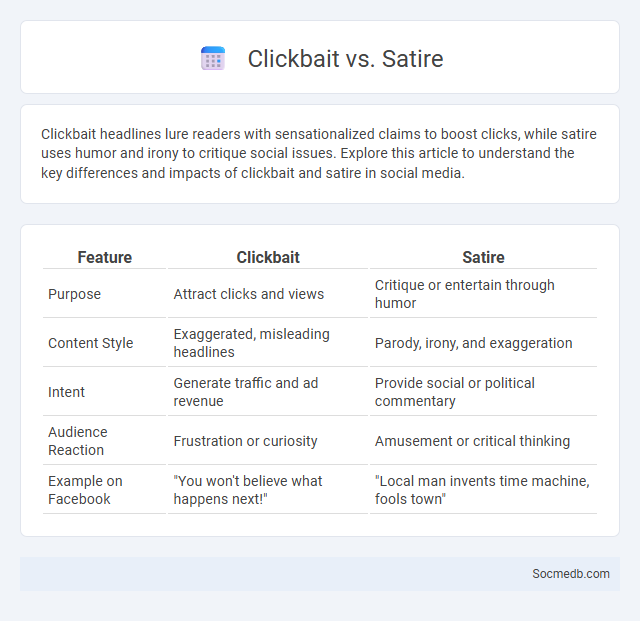
Photo illustration: Clickbait vs satire
Clickbait headlines lure readers with sensationalized claims to boost clicks, while satire uses humor and irony to critique social issues. Explore this article to understand the key differences and impacts of clickbait and satire in social media.
Table of Comparison
| Feature | Clickbait | Satire |
|---|---|---|
| Purpose | Attract clicks and views | Critique or entertain through humor |
| Content Style | Exaggerated, misleading headlines | Parody, irony, and exaggeration |
| Intent | Generate traffic and ad revenue | Provide social or political commentary |
| Audience Reaction | Frustration or curiosity | Amusement or critical thinking |
| Example on Facebook | "You won't believe what happens next!" | "Local man invents time machine, fools town" |
Understanding Clickbait: Definition and Purpose
Clickbait refers to sensationalized or misleading headlines designed to attract clicks and drive web traffic by exploiting curiosity gaps. Its primary purpose is to increase engagement metrics such as page views, shares, and ad revenue, often at the cost of content quality or accuracy. Understanding clickbait helps you recognize manipulative tactics and make informed decisions about the content you choose to engage with on social media platforms.
The Essence of Satire: Humor, Irony, and Critique
Satire on social media harnesses humor and irony to deliver sharp critiques of societal norms, politics, and cultural trends, fostering engagement and reflection among diverse audiences. Memes, parodies, and viral posts amplify these satirical messages, driving widespread dissemination and interaction. This blend of entertainment and critique leverages social platforms' reach, shaping public discourse and challenging prevailing narratives.
Key Differences Between Clickbait and Satire
Clickbait uses sensational headlines and misleading content to lure users into clicking, often prioritizing traffic over truth, while satire employs humor and irony to critique or highlight social issues. Your engagement with social media requires discerning between clickbait's manipulative intent and satire's purpose to provoke thought through wit. Recognizing these key differences enhances your ability to navigate digital platforms critically and avoid misinformation.
Psychological Triggers: Why Clickbait Works
Clickbait leverages psychological triggers such as curiosity, fear of missing out (FOMO), and emotional arousal to drive user engagement on social media platforms. By crafting headlines that provoke intrigue or urgency, clickbait exploits the brain's natural response to novel or surprising information, prompting impulsive clicks. Studies reveal that these triggers activate reward centers in the brain, reinforcing the behavior and increasing shareability across networks.
Satire’s Social Impact: Informing Through Entertainment
Satire on social media platforms effectively informs audiences by blending humor with critical social commentary, making complex issues more accessible and engaging. Viral satirical content encourages reflection and dialogue on political and cultural topics, often sparking widespread awareness beyond traditional news outlets. By leveraging entertainment, satire amplifies public understanding and challenges dominant narratives, reinforcing its role as a powerful tool for social change.
Clickbait’s Influence on Online Media Consumption
Clickbait headlines significantly impact online media consumption by attracting user attention and increasing click-through rates through sensationalized or misleading content. This strategy manipulates emotions and curiosity, often leading to lower-quality engagement and distorted perceptions of news or information. You should critically evaluate content sources to avoid falling prey to clickbait and ensure a more accurate understanding of the information presented.
Recognizing Satirical Headlines vs. Clickbait Titles
Distinguishing satirical headlines from clickbait titles requires analyzing content tone and source credibility, as satirical headlines often use humor and irony to critique social issues, while clickbait prioritizes sensationalism to drive clicks. Recognized platforms such as The Onion or SatireWire consistently produce satirical content, enabling readers to develop discernment by examining context and linguistic cues. Monitoring engagement metrics like bounce rates and reader comments also aids in identifying misleading clickbait versus intentionally humorous satire.
Case Studies: Famous Examples of Clickbait and Satire
The New York Post's article titled "Jennifer Lawrence Bares All in New Film" leveraged provocative headlines to drive massive traffic, exemplifying clickbait's power in media sensationalism. The Onion's satirical piece "Area Man Passionate Defender Of What He Imagines Constitution To Be" showcases how satire uses humor and irony to critique social and political issues, engaging audiences by blending entertainment with sharp commentary. Both cases highlight how strategic headline crafting and content framing influence user engagement and information perception across social platforms.
Ethical Implications of Clickbait and Satirical Content
Clickbait headlines exploit human curiosity by misleading users, eroding trust in social media platforms and distorting the quality of information you consume. Satirical content, while valuable for social critique, often blurs the line between fact and fiction, requiring critical media literacy to avoid misinformation. Balancing engaging content with ethical responsibility is essential for fostering a well-informed, respectful online community.
Navigating the Digital News Landscape: Tips for Readers
Navigating the digital news landscape requires critical evaluation of sources, verifying information through multiple reputable outlets, and recognizing bias to avoid misinformation. Readers should utilize fact-checking tools and stay updated on algorithm changes that influence news feed personalization. Engaging with diverse perspectives fosters a well-rounded understanding of current events in the ever-evolving social media environment.
 socmedb.com
socmedb.com